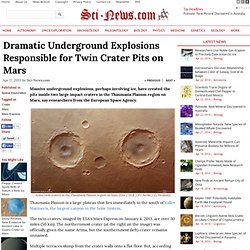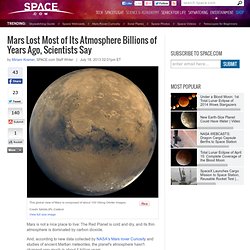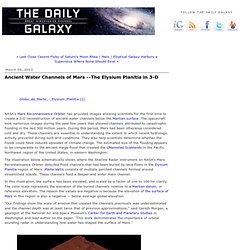

Mars-Planet. Toxic Mars Chemical Throws Wrench Into Search for Red Planet Life. Astronauts sent to Mars on future space missions may have to contend with a toxic chemical known as perchlorate that's thought to be widespread in Red Planet dirt.

But perchlorates are already proving problematic for researchers using robots to hunt for possible traces of Martian life, a new study has found. As part of its science mission, NASA's Mars rover Curiosity heats up scoops of Red Planet dirt to test for organic carbon compounds — the building blocks of life on Earth. But that heat can cause perchlorates in soil samples to set off a chemical reaction that destroys organics, researchers discovered. [The Hunt for Martian Life: A Photo Timeline] "The presence of perchlorates isn't good news for some of the techniques we’re currently using with Curiosity," study lead author Daniel Glavin, an astrobiologist at NASA’s Goddard Space Flight Center in Greenbelt, Md., said in a statement.
The recent findings at Rocknest could help scientists establish this baseline. Dramatic Underground Explosions Responsible for Twin Crater Pits on Mars. Massive underground explosions, perhaps involving ice, have created the pits inside two large impact craters in the Thaumasia Planum region on Mars, say researchers from the European Space Agency.

Arima twin craters in the Thaumasia Planum region on Mars (ESA / DLR / FU Berlin / G. Neukum) Thaumasia Planum is a large plateau that lies immediately to the south of Valles Marineris, the largest canyon in the Solar System. The twin craters, imaged by ESA’s Mars Express on January 4, 2013, are over 30 miles (50 km). The northernmost crater (at the right on the image) was officially given the name Arima, but the southernmost (left) crater remains unnamed. Multiple terraces slump from the crater walls onto a flat floor. When an asteroid hits the rocky surface of a planet, both it and the surface are compressed to high densities.
A perspective view of a 30-mile crater in Thaumasia Planum, Mars (ESA / DLR / FU Berlin / G. Curiosity Provides New Evidence for Warm, Wet Ancient Mars. A large international team of researchers used Curiosity’s Sample Analysis at Mars (SAM) suite of instruments to measure the abundances of different gases and isotopes in samples of Martian air.

This is an artist’s impression of habitable Mars (Daein Ballard / CC BY-SA 3.0) Isotopes are variations of the same chemical element that contain different numbers of neutrons, such as the most common carbon isotope, carbon-12, and a heavier stable isotope, carbon-13, which contains an additional neutron.
“The beauty of these measurements lies in the fact that these are the first really high-precision measurements of the composition of Mars’ atmosphere,” said Prof Sushil Atreya from the University of Michigan, who is a co-author of a pair of papers published in the journal Science (paper 1 & paper 2). Curiosity’s SAM analyzed the ratios of heavier to lighter isotopes of carbon and oxygen in the carbon dioxide that makes up most of Mars’ atmosphere today.
Bibliographic information: Chris R. Paul R. Mars Lost Most of Its Atmosphere Billions of Years Ago, Scientists Say. Mars is not a nice place to live: The Red Planet is cold and dry, and its thin atmosphere is dominated by carbon dioxide.

And, according to new data collected by NASA's Mars rover Curiosity and studies of ancient Martian meteorites, the planet's atmosphere hasn't changed very much in about 4 billion years. Scientists suspect that, after Mars' violent formation about 4.5 billion years ago, something caused the planet to lose its atmosphere, which is now only about 1 percent as thick as that of Earth. [Mars Rover Curiosity's 7 Biggest Discoveries (So Far)] Mars' Grander Canyon - Hebes Chasma Fly-Though. 8 mysterious images of Mars: The red planet. You’ll Only See This Landform on Mars, Nowhere on Earth. Want to stay on top of all the space news?

Follow @universetoday on Twitter Periodic Bedrock Ridges on Mars. Image credit: University of Washington Geologists are often surprised to find features on Earth replicated on other worlds; ancient riverbeds on Mars, lakes on Titan, and volcanic eruptions on Io. But researchers from the University of Washington have identified a geologic feature that exists on Mars… But not on Earth.
“These bedforms look for all the world like sand dunes but they are carved into hard rock by wind,” said David Montgomery, a UW professor of Earth and space sciences. A yardang in Texas. What could create such a unique feature? Ancient Water Channels of Mars. In this illustration, the surface has been elevated, and scaled by a factor of one to 100 for clarity.

5 Reasons You Should Be Excited About Mars Today. Perhaps the most popular cosmic story of the past decade was that Pluto was no longer a planet.

Everyone shared it, and everyone knew about it. However, on a list of the most important scientific discoveries of the past decade, "Pluto is no longer a planet" ranks just under "everything else" and just above nothing. This evening, however, at about 10:30 PST, something pretty incredible will likely occur, and it has nothing to do with the Olympics. Curiosity, the Mars Science Laboratory, is supposed to land on the red planet tonight or today, depending on where you happen to be on Earth. Now, I don't claim to be an astrophysicist. . #5. Curiosity has been flying toward Mars for almost a year now. Planet of a Thousand Mysteries. 91: The Search for Water on Mars. Extensive water in Mars' interior. © NASAMars, as seen by the Hubble Space Telescope.

Until now, Earth was the only planet known to have vast reservoirs of water in its interior.